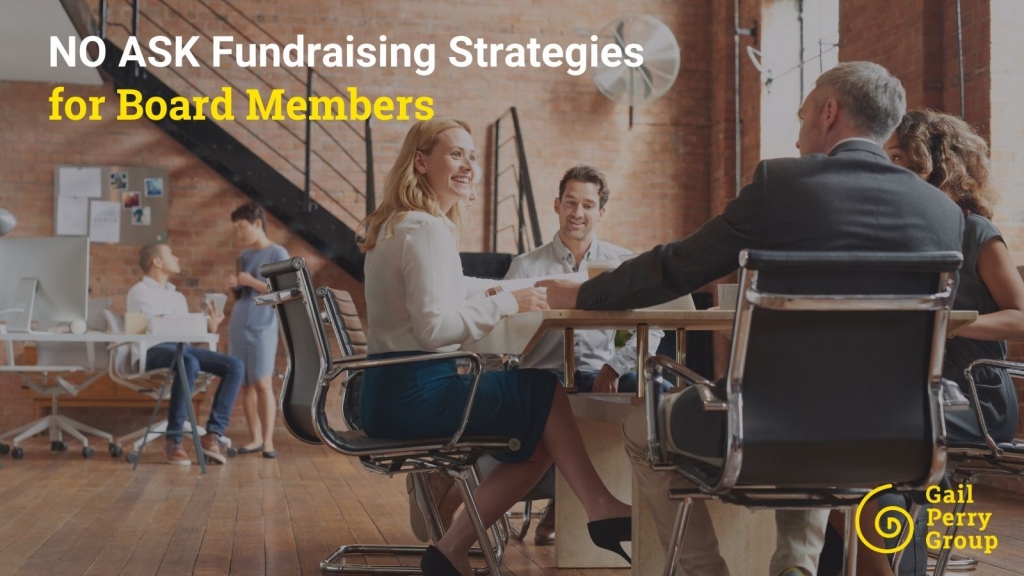
NO ASK fundraising strategies for board members? Is this possible?
Often, we find that board members are nervous about the idea of fundraising. They want to help, but shy away from the idea of “asking.”
We recently shared our favorite list of the Top 10 Fundraising Responsibilities of Board Members. Today we want to dive deeper and discuss how each board member can find a comfortable role where they can personally support fundraising, without having to solicit.
Here are just a few of the productive jobs they can do to raise friends, thank donors and help create a sustainable fundraising program.
1. Spread the word among their networks and social circles.
Your board members need to be roaring advocates for your organization; they need to talk it up wherever they go. Every organization needs their board members to be in action, spreading the word and making friends for the cause.
It’s important for all board members to enthusiastically share news about their favorite cause with their friends. Most are willing to share posts, videos or images with their social networks. For example, many board members jump in to support Giving Days by reaching out to friends via social or digital channels.
One thing board members need to remember: they have immense credibility within their communities.
One reason is because they are unpaid volunteers. They are only supporting the organization out of the goodness of their hearts – because they care. This gives board members more stature within the community and their circles of friends than they realize.
So the job is clear: ask your board members to introduce your organization to everybody they know. Let’s start a groundswell of good news about your cause that will spread through your community.
2. Open doors by hosting Small Socials.
You can expand your community relationships and make new friends through gatherings such as Small Socials. This job is perfect for socially oriented board members who have a large network.
A Small Social can take several formats. For example, it can be a coffee, a tea, a dinner, a porch party, a cookout, or cocktails. The event can be a breakfast meeting or luncheon. It can include 3 people or 100.
Here’s our preferred format for a “door-opener” Small Social:
- Board members, volunteers or donors invite guests, underwrite it and serve as hosts.
- There is no charge, because this is a cultivation event designed to introduce new people to your organization’s work. The goal is to work the room, so to speak.
- There is a short presentation (max 15 minutes) in the midst of the socializing.
- The board volunteer host welcomes everyone, and the CEO gives a short high-impact message about the work and your results.
- You follow up with attendees after the event, by asking them about their impressions and if they’d like to get involved.
Small Socials are one of our favorite no ask fundraising strategies for board members. Opening doors and making connections is a most important role – one that can pay off in future major gifts.
3. Host a tour to showcase your organization’s impact.
Board members can host tours to bring prospective friends closer to your organization. We find that a carefully scripted tour can be a powerful way to demonstrate your organization’s good work and to illustrate unmet needs in the community.
The tour lets your work speak for itself.
Your guests will hear staff members, or even clients/students/stakeholders, express in their own words their personal first-hand experiences with your organization’s mission— and the good it does—in the community.
A well-planned tour is hosted by a board volunteer. Just like in Small Socials, the CEO will share a visionary message. Use the same follow-up plan as a Small Social.
By hosting a tour of your organization for donors or friends, board members play a powerful role showcasing your organization’s work. Even more, their presence adds credibility and stature to your organization.
4. Thank you calls to donors.
One of the most powerful actions a board member can take is to make thank you phone calls to donors. This should always happen soon after the gift is received by your organization.
When board members call to thank donors, the donors are usually quite impressed. Donors will think:
“This organization appreciates me”
“I am a real person to this organization, not just a checkbook”
“This organization is well run”
Donors who receive phone calls from board members invariably tend to give larger gifts the next time and tend to stay on board as donors longer.
Some studies have shown that donors who received a thank you call from a board member within 24 hours of making a gift, later made subsequent gifts that were 39% higher than donors who did not receive a call.
This means that board members can directly improve your organization’s bottom line without having to solicit.
Bottom Line: NO ASK Fundraising Strategies for Board Members
Every board member can support your organization’s fundraising.
There is a fundraising role for each person on your board – whether they are in an asking role or not. Opening doors, making friends and thanking donors are valuable jobs that can pay off with increased gifts to support your cause.
As always, it is a pleasure to share our weekly news and insights with you.
If your organization is planning a capital campaign or launching a major gifts program – we can help. We’re with our clients every step of the way, inspiring their teams and board, building confidence, driving action and measuring success. Send an email to coaching@gailperry.com if you’d like to schedule a strategy or consulting call with us.
